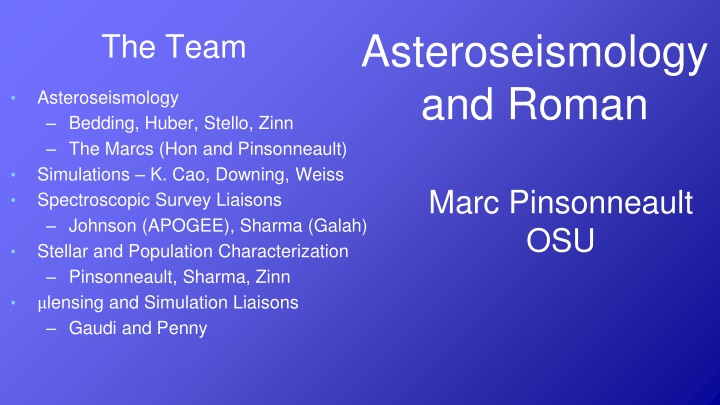
Unlocking the Mysteries of Galactic Giants with Asteroseismology and Roman
Explore the groundbreaking work in asteroseismology and how the Roman Telescope is key in unraveling the secrets of cool evolved giants in the Galactic Bulge. Discover the potential of Roman as the largest asteroseismic sample, with insights from leading researchers in the field.
Download Presentation

Please find below an Image/Link to download the presentation.
The content on the website is provided AS IS for your information and personal use only. It may not be sold, licensed, or shared on other websites without obtaining consent from the author. If you encounter any issues during the download, it is possible that the publisher has removed the file from their server.
You are allowed to download the files provided on this website for personal or commercial use, subject to the condition that they are used lawfully. All files are the property of their respective owners.
The content on the website is provided AS IS for your information and personal use only. It may not be sold, licensed, or shared on other websites without obtaining consent from the author.
E N D
Presentation Transcript
Asteroseismology and Roman The Team Asteroseismology Bedding, Huber, Stello, Zinn The Marcs (Hon and Pinsonneault) Simulations K. Cao, Downing, Weiss Spectroscopic Survey Liaisons Johnson (APOGEE), Sharma (Galah) Stellar and Population Characterization Pinsonneault, Sharma, Zinn lensing and Simulation Liaisons Gaudi and Penny Marc Pinsonneault OSU
Why Do Asteroseismology With Roman? The Galactic Bulge is a fascinating, and poorly understood, galactic population Cool evolved giants are potent population tracers The GBTDS is ideally suited to measure ages of giants through the tools of asteroseismology
Asteroseismology Summarized STANDIN G WAVES BRIGHTNESS VARIATIONS Oscillation Frequencies That Depend Sensitively on Mass and Radius! TURBULENCE
Red Clump: Powerful Population Diagnostic Pinsonneault+2024 Samples a wide range of ages and abundances at similar magnitude, color max=> M => age Excellent stellar inference validation set
Why Do We Need Roman? Kepler and K2 mostly sample the solar circle TESS provides a large, but bright and local, sample
Initial Simulations: The Roman GBTDS Could Detect Oscillations Low L -> High L Detectable Key Challenge 1: Detectable Saturated Star Photometry Gould+2015
Roman: Potentially The Largest Asteroseismic Sample Up to 600,000 detections! Huber+2023
Downing Poster Task 1: Detection Simulations Two Approaches: Kepler empirical and Gadfly simulations Two Noise Models Two Cadences Data from R. Wilson
Key Challenge 2: Noise Floor Noise Floor of 1 mmag (Penny+2019): Sample size reduced by a factor of 3 vs. Gould+2015 A second set of exposures per 15 minute cycle matters! Huber+2023
Penny 7.5 min Penny 15 min Wilson 15 min
Task 2: Population Simulations Simulate Underlying Populations with Galaxia Use Detection Simulations to Predict Yields Test Extinction Models Weiss Poster
Asteroseismology: Stellar Parameter Validation Two Steps: Spectroscopy -> Photometry Gives Teff and Metallicity Differential Astrometry Gives Radii if Tied to Gaia Note: This is existing high- resolution spectroscopic data; much more can be obtained
Next Steps And Recommendations Asteroseismology is an exciting prospect for Roman Having a higher cadence for at least some fields will be valuable for asteroseismology Upcoming work: using saturated star experiments; refining yields; exploring astrometry
Wilson 7.5 m Penny 15 m
Interpreting the Frequency Spectrum: Scaling Relations 16 Cyg A (Kepler Data) Frequency of Maximum Power max Acoustic cutoff frequency that depends on log g Metcalfe+ 2012 Frequency Spacing Stellar pulsation theory predicts that the frequency spacing is related to the mean density With Abundance Information (Spectra): Can Infer Ages
